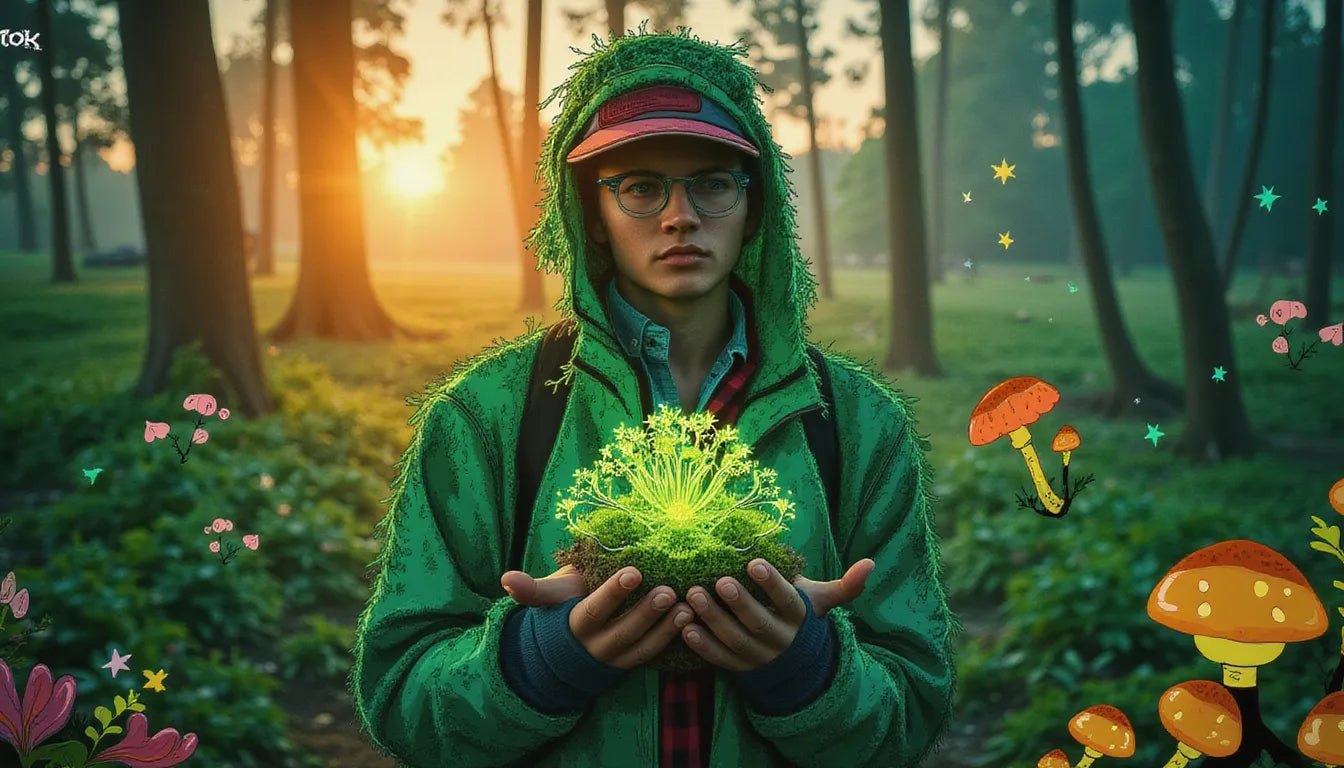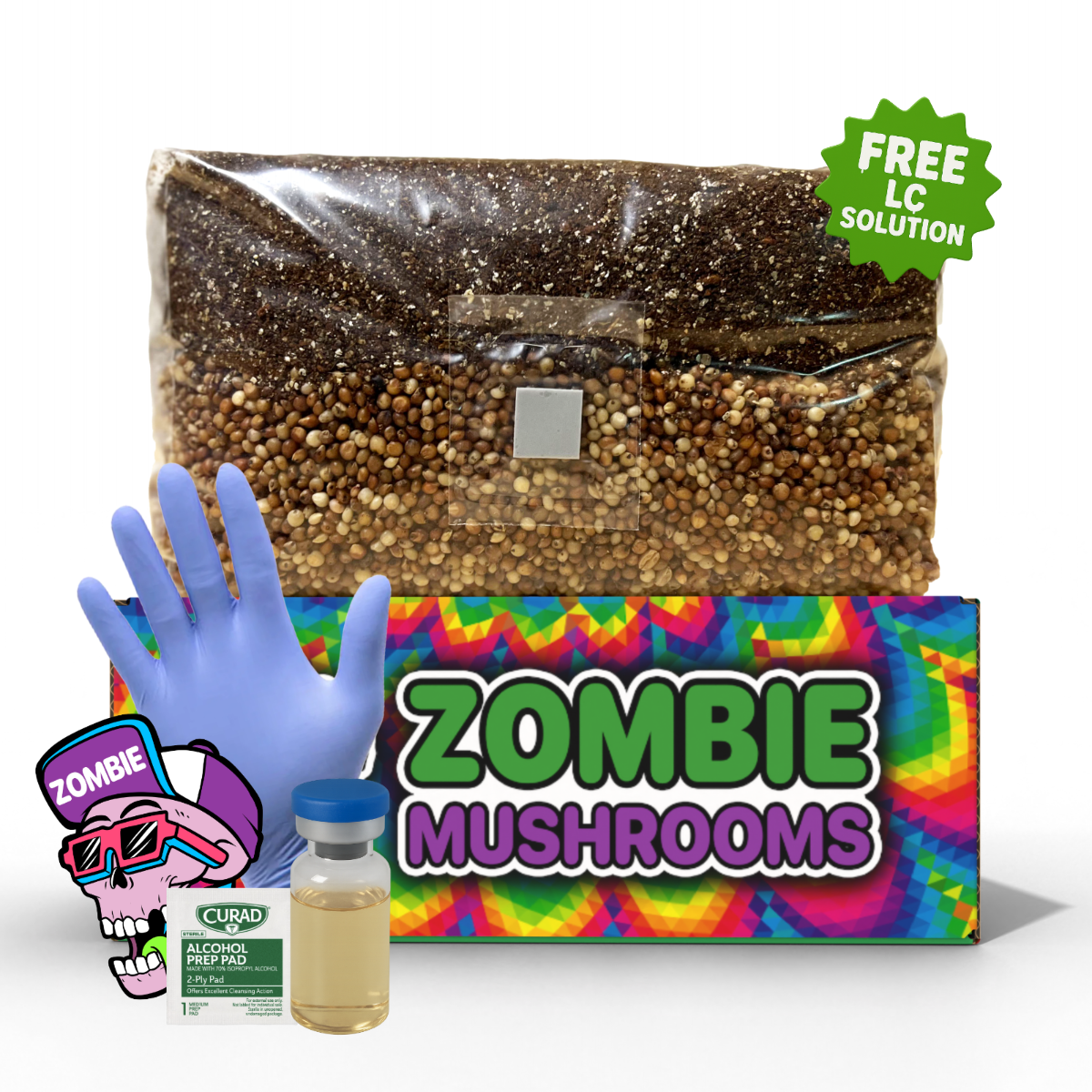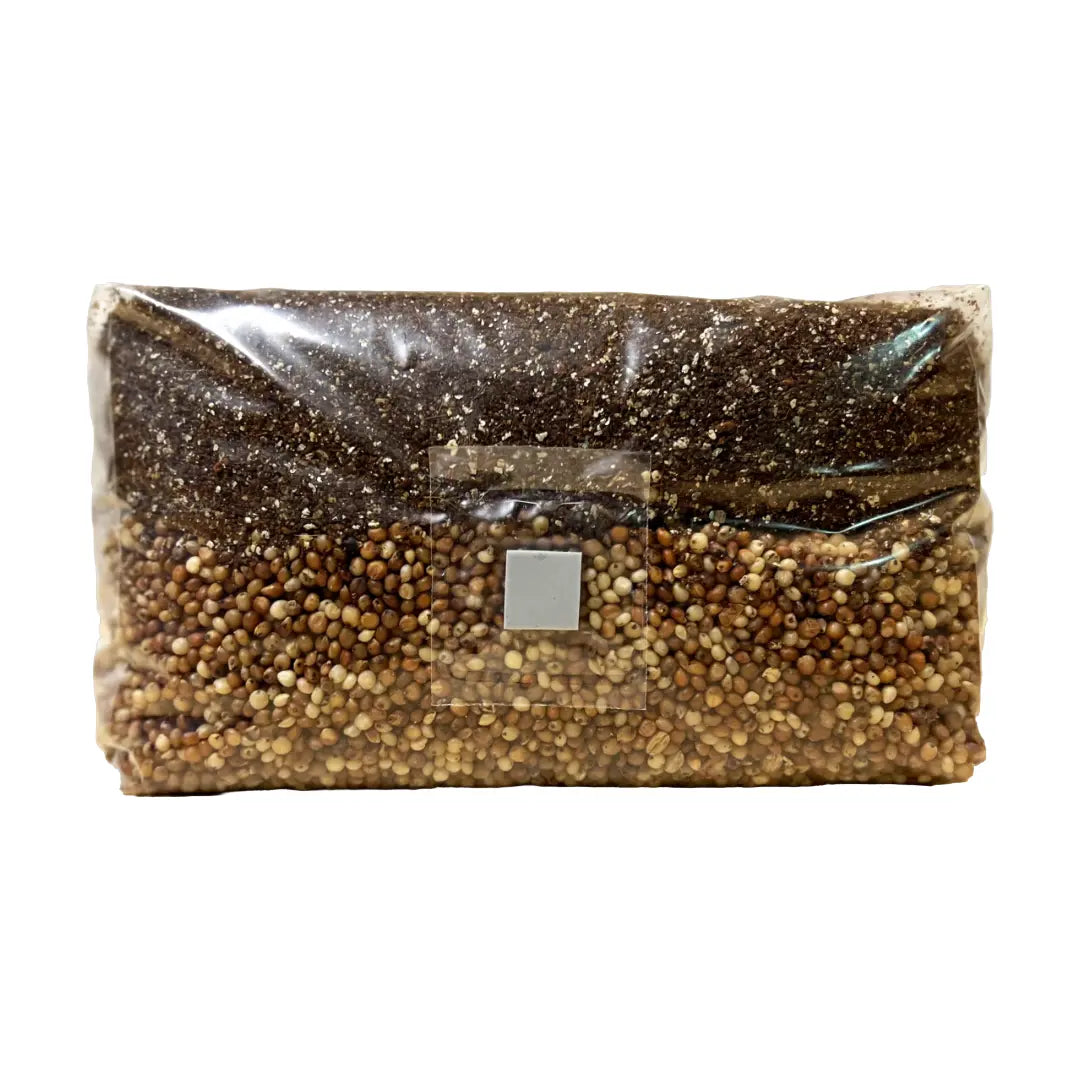⬇️ Prefer to listen instead? ⬇️

- Fungi can sequester up to 70% of soil carbon in forests, contributing to keeping the air clean.
- Oyster mushrooms decomposed 97% of diesel contaminants in four weeks in field tests.
- Mycelium-based biomaterials offer sustainable alternatives to plastics, foams, and leathers.
- Mycelium filters naturally remove pollutants from water, reducing heavy metals and oil runoff.
- Mushroom farming emits far less CO₂ than many crops, supporting food sustainability and environmental goals.

Mushrooms and the Environment: Can They Save Earth?
Pollution, resource depletion, and global warming are accelerating planetary decline, but one of Earth’s most ancient organisms could help reverse the trend: mushrooms and their extraordinary underground lifeforms. With high adaptability and biologically potent abilities, fungi and their mycelium networks are gaining recognition as powerful environmental allies, and using mushroom grow bags is one way people can cultivate them at home.
From breaking down pollutants to restoring degraded soils and reducing atmospheric carbon, these natural decomposers might offer profound solutions to some of our most pressing environmental challenges.

What is Mycelium and Why It Matters
Mycelium is the hidden, thread-like root structure of fungi. It spreads beneath the surface as a dense network of hyphae—fine, filamentous structures that search for nutrients and organic matter to decompose. This underground matrix isn't just a source of sustenance for the fungi; it's a nutrient highway and communication network for entire ecosystems.
Often dubbed the “Wood Wide Web,” mycelial networks play a critical role in connecting plants through symbiotic relationships, particularly with mycorrhizal fungi. Trees, shrubs, and grasses connect via these fungi, which enable nutrient and water exchange. In turn, plants provide the fungi with sugars and other organic compounds through photosynthesis. This nutrient exchange boosts ecosystem resilience by allowing symbiotic support during droughts, disease, or nutrient stress.
Mycelium also aids in soil hydration and microbe development, and it helps a lot with ecosystem biodiversity. Its presence in forest floors helps build strong soil structure, resists erosion, supports root systems, and improves the soil's ability to buffer extreme weather events. In this context, mycelium benefits extend far beyond the fungal kingdom—creating the biological scaffolding for life above ground.

Mycoremediation: Nature’s Fungal Cleanup Crew
One of the most important applications of fungi is their use in environmental detoxification, a field known as mycoremediation. This process uses fungi’s natural decomposing enzymes to neutralize environmental pollutants including petroleum hydrocarbons, heavy metals, and synthetic chemicals.
Certain mushroom species like oyster (Pleurotus ostreatus), turkey tail (Trametes versicolor), and Reishi (Ganoderma lucidum) are very good at breaking down complex and toxic compounds. Their mycelium secretes enzymes like laccases, peroxidases, and cellulases, which break down stubborn pollutants into simpler, often harmless compounds.
In one study, oyster mushrooms were used at a diesel spill site. After four weeks, they had broken down 97% of the diesel contaminants. Notably, the site began to sprout new plant life where other treatments failed—highlighting the fungi's regenerative power.
Mycoremediation has been tested for a variety of pollutants, including:
- Pesticides and herbicides used in industrial agriculture.
- Dioxins and polychlorinated biphenyls (PCBs), known for contaminating soil and waterways.
- Pharmaceuticals like antibiotics and hormones in wastewater.
Unlike chemical remediation, fungi-based approaches are ecologically gentle, energy-efficient, and cost-effective. They require little more than fungal cultures, organic substrates, and time—making mycoremediation a valuable tool for communities with limited access to industrial-scale cleanup solutions.

Combatting Soil Erosion and Regenerating Land
Modern agriculture, deforestation, overgrazing, and construction have left vast areas vulnerable to erosion and soil degradation. Without active intervention, previously fertile lands are turning to dust, triggering food insecurity and biodiversity loss. Fortunately, fungi offer a practical, biologically-driven way to stabilize and rebuild damaged soils.
Mycelium acts like a natural glue that binds soil particles together, which makes soil structure better and absorbs water. This “living net” reduces surface runoff and erosion, particularly in steep, degraded areas or regions affected by wildfires.
Moreover, mycelium helps regenerate soil by:
- Breaking down organic debris into nutrient-rich humus.
- Improving microbial communities essential for plant health.
- Helping symbiotic relationships that allow re-establishment of native vegetation.
These services are very important in post-mining sites, clear-cut forests, and monoculture farmlands. Initiatives using fungi-enriched compost, such as “spore slurries” or mulch infused with mycelium, are helping to kickstart the recovery of biologically dead soils.

Carbon Sequestration: A Fungal Fix for the Environment
Atmospheric carbon dioxide is a key driver of global warming, and while forests are well-known carbon sinks, fungi play an overlooked role in locking carbon underground. Mycorrhizal fungi form intimate partnerships with plant roots, drawing sugars from photosynthetic activity and using them—along with soil carbon—to build stable organic compounds, many of which resist decomposition for decades.
Averill et al. (2014) found that these mycorrhizal systems influence up to 70% of long-term carbon storage in forest soils. What makes fungal carbon so persistent is the chemistry of their cell walls. Mycelial structures are rich in chitin and glomalin—compounds that accumulate in soils and bind carbon effectively.
Furthermore, fungi enable plants to grow better, increasing above-ground biomass and carbon absorption. The result is a biologically fueled positive feedback loop of carbon sequestration:
- Fungi help plants grow.
- More plants absorb more carbon.
- Fungi store carbon in long-lived soil compounds.
Incorporating fungal-rich soil systems into agriculture, land restoration, and urban planning can vastly improve our carbon accounting—and offer nature-based solutions to meet environmental targets.

Breaking Down Plastic and Waste: The Biodegradation Frontier
One of the most exciting areas in mycology is the study of fungi's ability to degrade human-made waste, particularly plastics. Traditional plastics, including polyurethane and polystyrene, persist in the environment for centuries. But some fungi have developed mechanisms that make them capable of partial or complete plastic degradation.
Key discoveries include:
- Pestalotiopsis microspora, a rainforest fungus capable of breaking down polyurethane even in oxygen-free environments like landfills.
- White-rot fungi, including species of Trametes and Phanerochaete, shown to break down lignin in wood using peroxidase enzymes—enzymes that also affect plastic polymers.
These properties have inspired a new wave of sustainable design. Startups are using mycelium as a raw material for biodegradable alternatives to:
- Styrofoam packaging
- Leather (used in shoes, bags, and upholstery)
- Plastic containers and utensils
Instead of producing waste that lingers for centuries, mycelium products can decompose completely in compost within weeks—leaving no trace behind.
Water Filtration and Pollution Control
Fungal networks don't just stabilize soils and absorb carbon—they also clean water. Mycoremediation can be used in aquatic and riparian environments through a technique called mycofiltration. This method uses mats or barriers of fungal mycelium to intercept and purify contaminated water as it passes through soil or engineered systems.
Fungi-based filters can:
- Absorb petroleum-based runoff from roads and highways.
- Remove agricultural pollutants such as nitrates and phosphates.
- Bind and neutralize heavy metals like arsenic, lead, and mercury.
- Reduce bacterial pathogens including E. coli.
Projects using mycofiltration are becoming more popular across the globe. For instance, municipalities are deploying mushroom patches along drainage points or retention ponds, and citizen science initiatives are placing mycelium sacks in stormwater channels to filter runoff from industrial zones. This solution is not only low-cost but also scalable, opening new possibilities for eco-friendly water treatment.

Fungi and Food Sovereignty
Apart from environmental detoxification, mushrooms also offer big help for food security. They are rich in protein, fiber, and micronutrients like B-vitamins, selenium, and potassium—all while requiring minimal inputs to cultivate.
Compared to conventional crops or livestock, mushroom farming has a very small ecological footprint:
- Requires 90–95% less water than most vegetables.
- Grows on agricultural byproducts like straw, coffee grounds, or sawdust.
- Emits much less greenhouse gases.
A life cycle analysis by González-García et al. (2018) found that mushroom cultivation in Spain and Italy had much lower CO₂ emissions than traditional vegetable farming. This positions mushroom cultivation as a key strategy for local food production in a warming, resource-constrained world.
Additionally, the accessibility of mushroom grow kits has democratized mushroom farming. Homegrown mushrooms not only reduce transportation-related emissions but also empower communities to become more food-resilient.

Biomaterials: Mycelium Beyond the Forest
Beyond their role in decomposition and nutrition, mycelium is emerging as a core material in green innovation. Companies like Ecovative, MycoWorks, and MOGU are pioneering mycelium-based alternatives to petroleum-based materials, effectively turning fungus into a renewable manufacturing substrate.
These biomaterials are being developed into:
- Packaging foam that replaces Styrofoam.
- Leather-like materials for fashion and interiors.
- Acoustic insulation panels.
- Durable, lightweight construction blocks and bricks.
Such products offer a direct path away from extractive industrial systems and toward regenerative, biodegradable alternatives. When a mycelium item outlives its use, it can be safely composted—completing a truly circular lifecycle.

Challenges to Large-Scale Mycoremediation
Despite its great possibilities, applying fungi for environmental restoration at scale is not without hurdles:
- Fungal species must be matched carefully with the target environment and type of pollution.
- Environmental variables like temperature, pH, moisture, and substrate are very important for fungal viability.
- Regulatory approval processes for bioremediation still lag behind the research.
- Many fungi require time to establish and cannot offer immediate results compared to chemical methods.
To overcome these challenges, scientists are looking into genetic adaptation, breeding for resilience, and better fungal consortia that can handle more extreme environments.
Better collaboration between policy-makers, ecologists, and biotechnologists will be needed to bringing mycoremediation from lab-scale innovation to global restoration strategy.
The Future of Environmental Mycology
Environmental mycology—the study and application of fungi for ecological benefits—is increasingly being integrated into conservation, environmental, and urban planning strategies. From academic research to grassroots movements, the applications are growing:
- Schools are introducing mycology in science curriculums.
- Urban farms are using mushroom compost for nutrient cycling.
- Community gardens are trying vertical stacks of gourmet mushrooms.
- Nonprofits and startups are offering training in decentralized mycoremediation.
Moreover, fungi are being looked at for planetary resilience beyond Earth—some scientists are studying fungi’s applications for cleaning extraterrestrial environments and producing food in closed-loop life support systems.
How to Get Involved: From Backyard to Biosphere
You don’t need a degree in biology or a high-tech lab to make a difference with fungi. Start at home:
- Try a mushroom grow kit from eco-conscious companies like Zombie Mushrooms.
- Use spent mushroom substrate to fertilize your garden naturally.
- Join citizen science initiatives about fungal biodiversity or restoration.
Whether you're restoring a piece of degraded land or simply composting with fungi, every small action contributes to a culture of regeneration.
Fungi offer more than ecological functions; they offer a philosophy of collaboration, transformation, and renewal.
Could Mushrooms Help Save Earth?
Mushrooms may not command attention the way trees or whales do, but their power lies in their subtlety and ubiquity. Their intricate underground webs, enzyme systems, and material innovations represent a living toolkit for Earth's healing. From cleaning toxic soils to offering us compostable packaging, fungi knit together ecosystems and inspire us to rethink waste, growth, and sustainability itself.
By growing mushrooms, supporting mycological research, or simply spreading fungi-friendly practices, we can all become a part of the great mycelial movement to restore the Earth. The path to environmental resilience may well be paved with spores and hyphae—one fungal thread at a time.
Citations
-
Averill, L. C., Turner, B. L., & Finzi, A. C. (2014). Mycorrhiza-mediated competition between plants and decomposers drives soil carbon storage. Nature, 505(7484), 543–545.
https://doi.org/10.1038/nature12901 -
González-García, S., Gasol, C. M., Lozano, R. G., & Moreira, M. T. (2018). Environmental benchmarking of mushroom production in Spain and Italy. Science of the Total Environment, 625, 1131–1143.
https://doi.org/10.1016/j.scitotenv.2018.01.002



